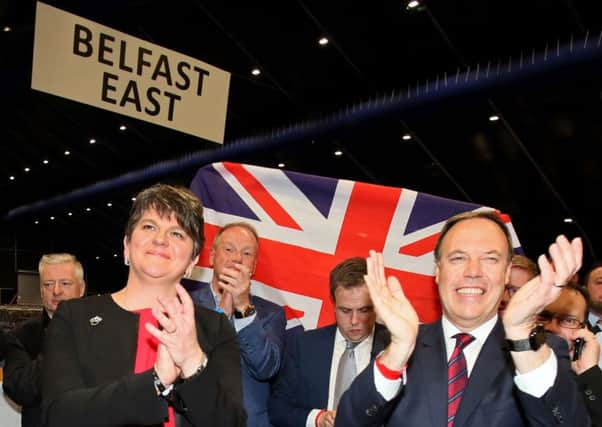Who are the DUP and what might they demand?


With 650 MPs in Parliament, 326 seats are needed for an absolute majority in the House of Commons.
But in practice, a working majority will require just 322 MPs, as the Speaker does not vote and Sinn Fein has so far declined to take up its seats.
Advertisement
Hide AdAdvertisement
Hide AdMrs May would be able to pass this crucial figure with the support of the DUP but the Ulster party will demand significant concessions in return for propping up her adminstration.
With the party in a position to hold the balance of power at Westminster, senior MP Sir Jeffrey Donaldson said his party would be “serious players” in a hung parliament.
He said: “This is perfect territory for the DUP because obviously if the Conservatives are just short of an overall majority it puts us in a very strong negotiating position and certainly that is one we would take up with relish.”
Who are the DUP?
The DUP is led by Arlene Foster in Northern Ireland and Sir Jeffery Donaldson in Westminster. It is the largest party in Northern Ireland, is pro-union and supports Brexit.
They have ruled out working with Labour in any coalition.
What might they demand?
The DUP are likely to focus on Irish border issues post-Brexit and will want to ensure there is no hard border with the Republic which could harm trade.
Hung parliament
With the General Election ending in a hung parliament, there could be days or weeks of political horse-trading before the final form of the next government is settled.
In 2010, Gordon Brown held onto the premiership for six days as frantic negotiations took place, resigning only when it became clear that the Conservatives and Liberal Democrats had reached agreement on a viable coalition.
It is highly likely that Mrs May too would hold back on any resignation until she has had time to test whether she has the support to attempt to continue in office.
Advertisement
Hide AdAdvertisement
Hide AdThe first milestone for Mrs May would be June 13, when the House of Commons is due to return after the election. But a far more significant deadline is the Queen’s Speech on June 19, when the sovereign will read out the legislative programme of the new government.
Any Prime Minister would be unlikely to ask the Queen to present a programme if they did not believe it would secure the support of a majority of MPs in the Commons.
The Cabinet Manual drawn up in 2010 following the inconclusive result of that year’s election states that the incumbent government is “entitled to wait until the new Parliament has met to see if it can command the confidence of the House of Commons, but is expected to resign if it becomes clear that it is unlikely to be able to command that confidence and there is a clear alternative”.
Without a clear alternative, the parties would be expected to hold discussions to establish whether any of them is able to form an administration capable of commanding the confidence of the Commons. The Prime Minister can authorise the civil service to provide support in negotiations, as they did in 2010.
The Queen would not expect to become involved in any negotiations, but the Palace would be kept informed via representatives of the political parties or the Cabinet Secretary.
If no viable administration can be constructed which would be capable of getting its budget and its programme through Parliament, then voters could be asked to return to the polling stations for the third general election in as many years.